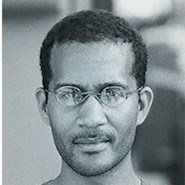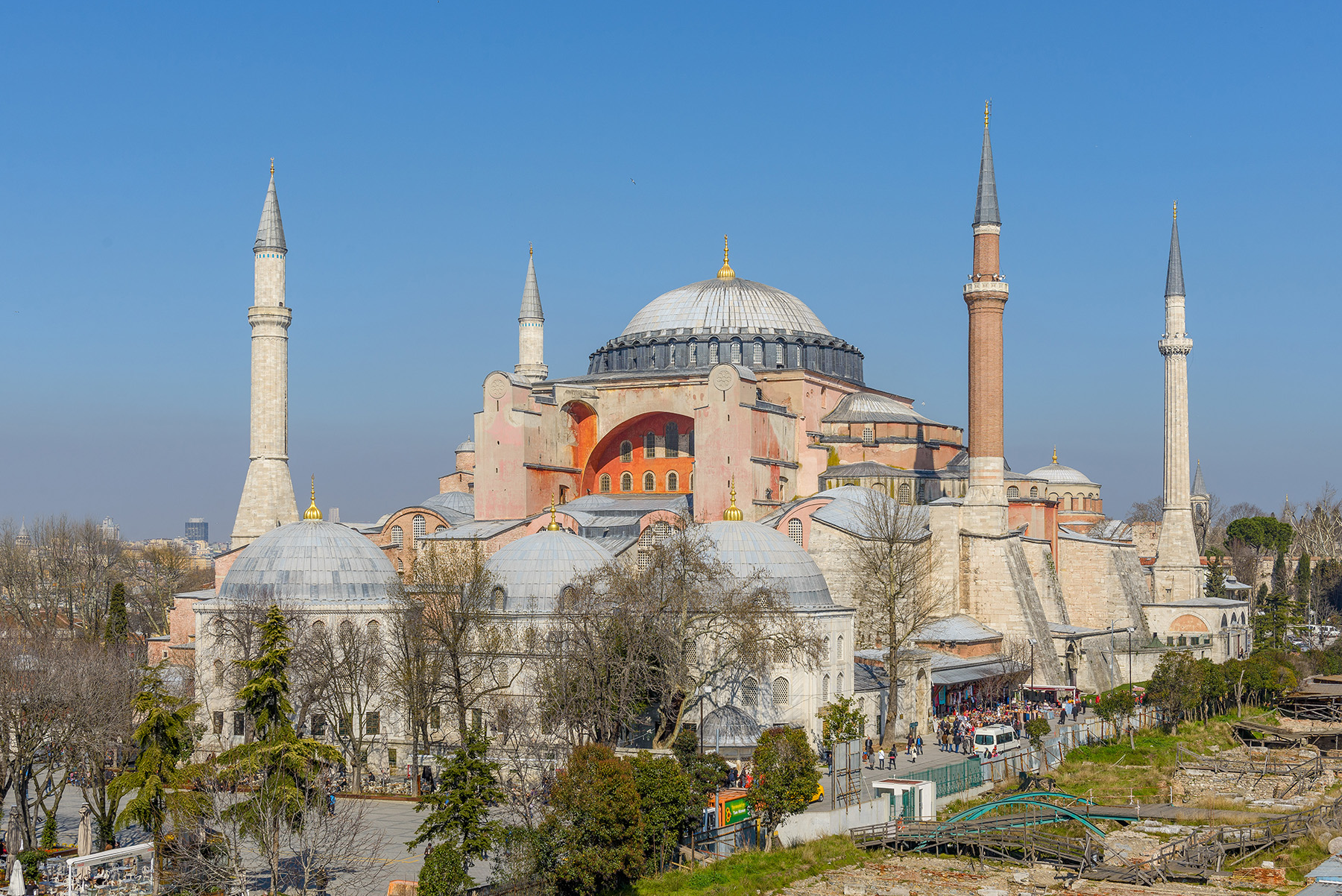
By T.R. Witcher
Istanbul’s Hagia Sophia is no stranger to lofty, poetic praise. Author Richard Winston, in his 2017 book Hagia Sophia: A History, recounts how the soaring church and mosque captured the imagination of writers over the centuries. To Michael of Thessalonica, a 12th-century scribe, the church was a cavernous “tent of the heavens,” which man — with an assist from God — had erected. The sixth-century Byzantine poet Paul the Silentiary, a courtier to Emperor Justinian I, wrote, “Whoever puts foot within the sacred fane, would live there, for ever, and his eyes well with tears of joy.”
Perhaps no writer has described it as lushly as Greek historian Prokopios, the chief scholar of the Byzantine Empire in the sixth century. Referring to its revolutionary gold mosaic dome, he marveled, “It seems not to be founded on solid masonry, but to be suspended from heaven by that golden chain and so cover the space.”
Hyperbole? Not to those who have seen it in person. There’s no question that the Hagia Sophia — from the Greek phrase “Holy Wisdom” — remains one of the great achievements in the art and engineering of buildings. It was the crowning glory of three empires spanning nearly 1,500 years as well as an enduring symbol of two world religions: Christianity and Islam. It was also named as a Historic Civil Engineering Landmark by ASCE.
Founded in 657 B.C., ancient Byzantium first came into prominence in A.D. 330, when Roman Emperor Constantine the Great named the city the eastern capital of the Roman Empire. First renamed New Rome, it soon became known as Constantine’s City — or Constantinople. Situated along the narrow strait of the Bosporus, which connects the Black Sea with the Sea of Marmara (which itself ultimately leads to the Aegean and Mediterranean seas), the town was a strategic trading center at the crossroads of the European and Asian continents.
Constantine was the first Roman emperor to convert to Christianity, and he envisioned a grand city that would rival Rome itself. It would fall to Constantine’s son, Constantius II, to build the first great cathedral in the city, on a thumb of land where the Bosporus meets the tiny Golden Horn estuary. This first iteration of the church, a wooden-roofed basilica named the Magna Ecclesia (Great Church), was completed by Constantius II in 360, but in 404 its roof was destroyed in a fire. The church was rebuilt by Emperor Theodosius II in 405. It stood until 532, when the whole building was razed during the so-called Nika riots, a protest against Emperor Justinian I, which resulted in the destruction of much of the city.
A mere 39 days later, as the city began rebuilding itself, work also commenced on a new and much larger church. It was dedicated as the Hagia Sophia we largely — though not entirely — know today. The masterminds behind the construction of this third church were two Greek architect-engineers from Asia Minor: Anthemius and Isidorus. Anthemius was an architect and mathematician; Isidorus was a professor of physics and stereometry — the geometry of 3D spaces. Both men, Winston wrote, were not just builders but “mathematicians trained in the theory of statics and dynamics — and, moreover, able to translate them into practice as engineers through training and instructing their team of technicians and craftsmen.”
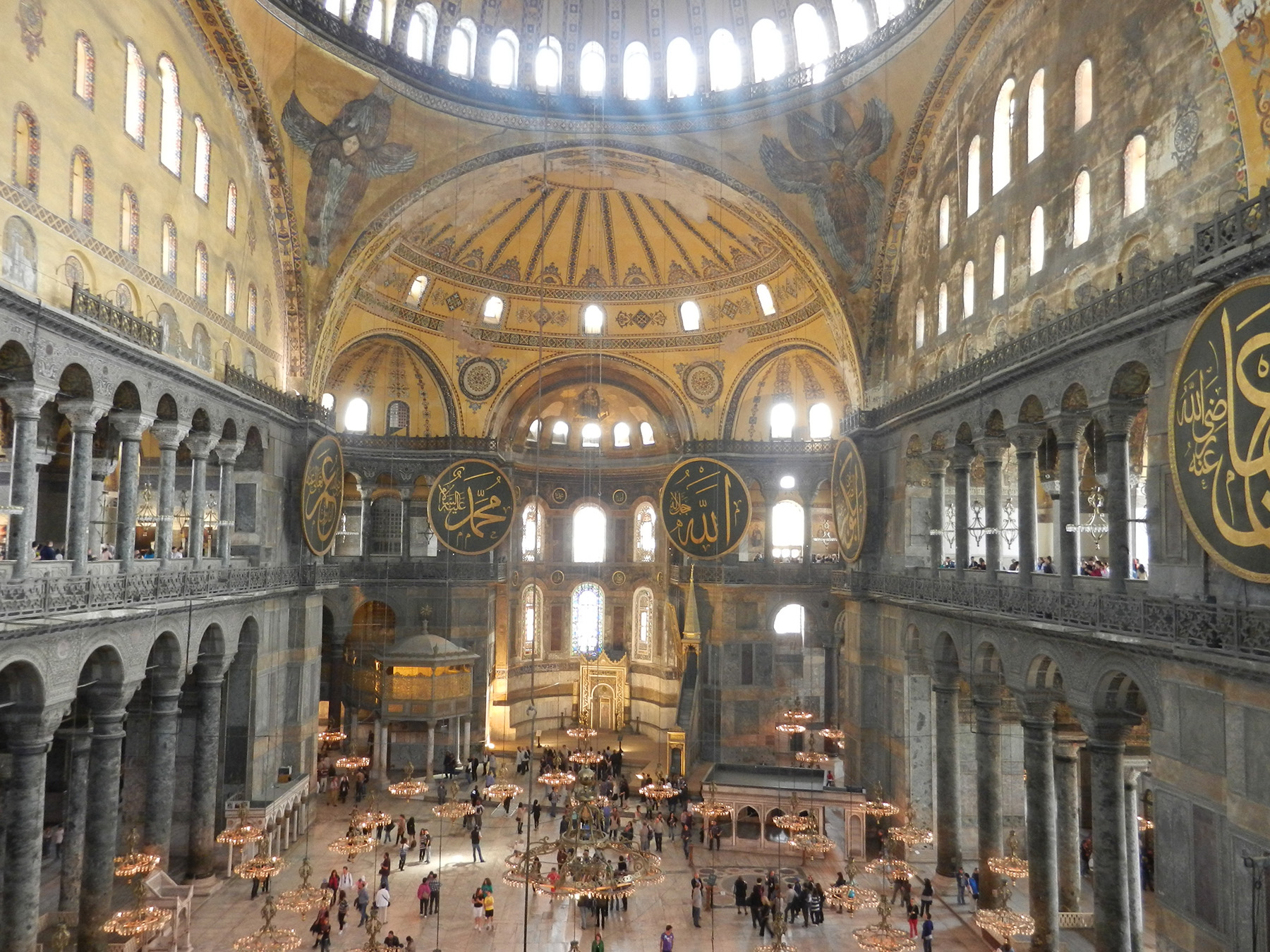
The design for the church borrowed the rectangular basilica form from Roman architecture and evolved another Roman design element, the dome, into a form that would define the technically complex and sensuous style of Byzantine architecture.
“Hagia Sophia is no cruciform church, like those of the Christian West,” wrote Winston, “but a domed Christian basilica on a centralized plan.” The building measured 220 ft by 250 ft. The dome measured 120.5 ft in diameter and soared approximately 182.5 ft above the ground.
According to the online World History Encyclopedia, builders constructed the dome with a brick aggregate that was “lighter and more plastic than solid stone or concrete, which allowed for the dome to create an internal space not surpassed in Western Europe for 1,000 years.”
Domes of antiquity were typically built atop circular structural supports — such as the Pantheon in Rome. But Hagia Sophia employed a far more sophisticated solution: a design that yielded astounding beauty and a structural headache.
The dome was supported by two pairs of arches, which joined together on massive triangular structures called pendentives that carried the dome’s load down to the foundation through four massive columns, or piers. (See the illustration on page 35.) The east and west arches below the dome joined giant and adjacent half domes on the building’s east and west edges, working in visual concert with the central dome to produce an astoundingly cavernous, light-draped interior. On the other hand, the arches at the north and south ends of the building were much thicker and were filled in with thinner masonry curtain walls, perforated by multiple windows.
The result was a new and almost overpowering sense of the fluidity of space itself: “Space floating in vistas,” as Winston put it, “rising vertically, expanding horizontally — a rhythm of voids concealing the function of the solid elements and creating a light, open, flowing construction.”
Prokopios, writing as the Hagia Sophia was being built, recognized these qualities as well: “All of these elements, marvelously fitted together in mid-air, suspended from one another and reposing only on the parts adjacent to them, produce a unified and most remarkable harmony in the work, and yet do not allow the spectators to rest their gaze upon any one of them for a length of time, but each detail readily draws and attracts the eye to itself.”
According to the book Mathematical Excursions to the World’s Great Buildings: First Edition, by mathematics professor Alexander J. Hahn, (Princeton University Press, 2012),“The fact that brick and mortar have little tensile strength meant that the hoop stress on the shell generated by the downward push of the weight of the dome needed to be controlled by a strong supporting structure at the dome’s base.” But because of the difference between the east-west and north-south arches — the “Hagia Sophia was … supported unevenly around its base.” It remains so.
Because of this dual system of support, the lateral thrusts of the dome, which are radial and equal in all directions, are countered on two sides by semidomes and on the other two by buttresses that do not lie in line with the forces they are intended to oppose, according to architectural historian Robert L. Van Nice in his paper “Hagia Sophia: New Types of Structural Evidence” (Journal of the Society of Architectural Historians, July-December, 1948, Vol. 7, No. 3/4, pages 5-9).
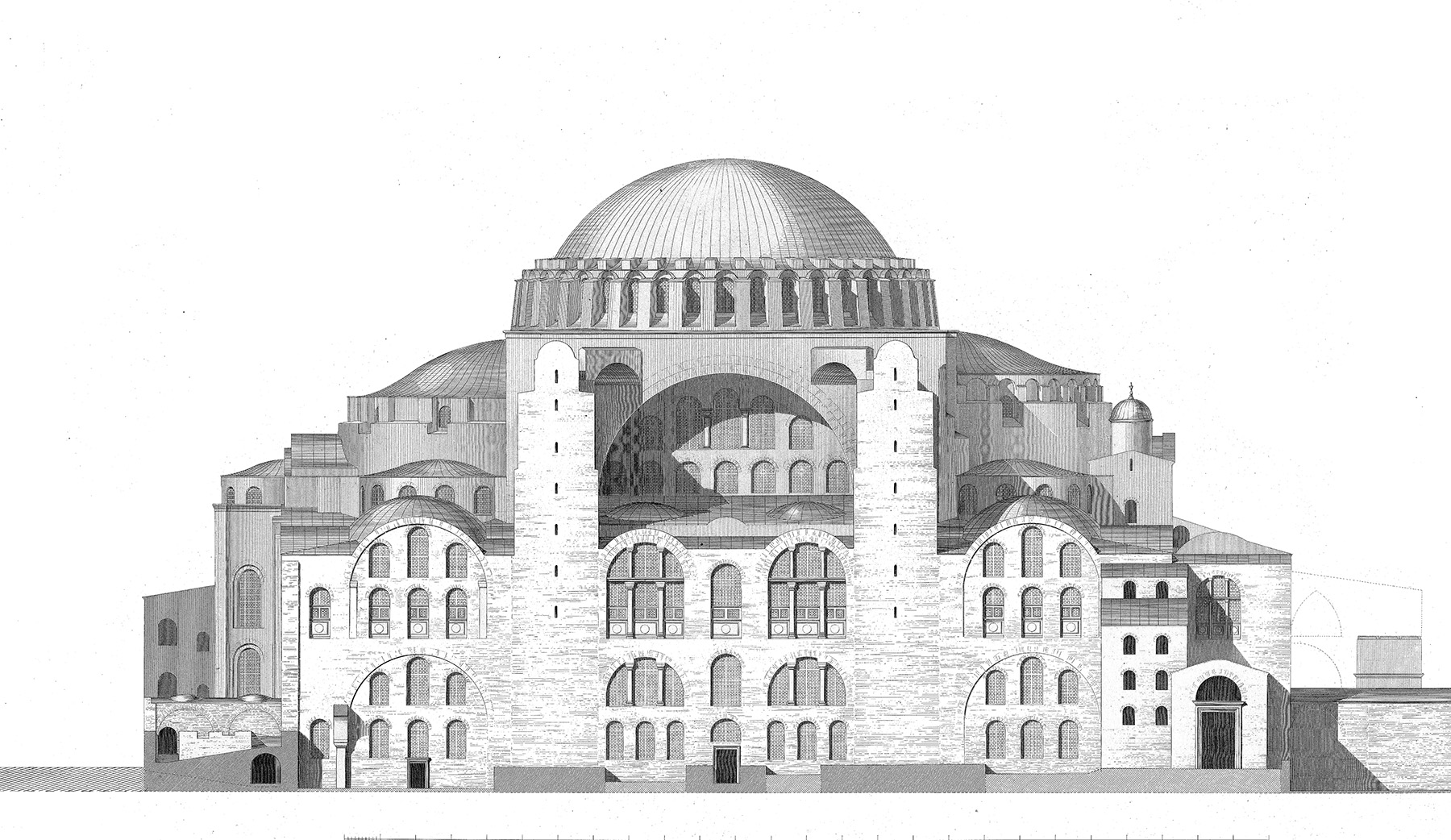
Those heavy masonry buttresses that were added, Hahn wrote, “to contain the thrust of the dome do not intrude on the interior space of the church, but they do take a toll on its outward appearance. The mound-like exterior of the Hagia Sophia lacks the rising elegance of its interior.”
Anthemius and Isidorus built the church quickly — in less than six years. Justinian, Winston wrote, employed some 10,000 men — 100 foremen each overseeing 100 workers. The emperor “shrewdly split his work force in two, with fifty foremen and their staffs working on the right half of the church and fifty on the left, so that the structure rose rapidly in a spirit of zealous competition.”
The interior of the space was adorned in elaborate fashion: Its columns were clad in green marble and purple polyphony, materials imported from as far away as Egypt, Italy, and the Atlantic coast of France. The interior was also decorated with copious amounts of silver and gold. “By day, the church was flooded diagonally with sunlight from the host of lunettes and round-headed windows,” Winston wrote. “By night, its artificial illumination was comparable to that of a midnight sun.”
The building’s dedication in 537 was equally lavish: Justinian, Winston added, “sacrificed 1,000 oxen, 6,000 sheep, 600 stags, and some 10,000 birds before giving 30,000 bushels of meal to the poor and needy.” The emperor purportedly proclaimed, “Solomon, I have outdone thee,” referring to the First Temple of Jerusalem built by the king of Israel almost 1,500 years earlier.
But Justinian’s boast lasted only a few decades. In 553, an earthquake weakened the crown of the eastern arch. Four years later, a second earthquake succeeded in splitting the arch completely. Efforts to repair it failed, and by 558, part of the eastern semidome and a large portion of the main dome itself had collapsed.
The collapse revealed another structural problem in addition to the church’s varying structural supports. The dome was too shallow, so it did not transfer loads cleanly down to the supporting piers but instead placed load on the walls, weakening them over time.
By this point Anthemius and Isidorus had died; work on a new dome was overseen by Isidorus’ nephew, Isidorus the Younger, and completed in 562. He rebuilt the dome and parts of its original supporting structures and raised its crown by 20.5 ft to reduce its lateral thrust. Isidorus the Younger also added 40 ribs to provide support. Windows ringing the base of the dome made it seem like it was almost floating in air.
The dome — and the monumental and beautiful quality of space and light it creates — is perhaps the singular achievement of this building, defining Byzantine architecture and, over time, influencing Islamic architecture, including the seventh-century Dome of the Rock Mosque in Jerusalem.
Several themes emerge in the history of Hagia Sophia: the reverent descriptions from writers across the centuries; the unquestioned symbolic import of the building, no matter what religion or culture controlled the city that would later become Istanbul; and — perhaps above all — a constant cycle of deterioration (often brought on by earthquakes) and restoration.
For instance, Isidorus the Younger’s second dome was damaged by two 10th-century earthquakes; repairs, according to Van Nice, were carried out by the Armenian architect Trdat. The Hagia Sophia, along with Constantinople, was sacked by the Crusaders in 1204; many of its Byzantine mosaics were carted off to Venice, and it was rechristened a Roman Catholic cathedral until 1261. A 1344 earthquake led to the collapse (again) of the eastern arch in 1347. The arch was restored (again) in 1354.
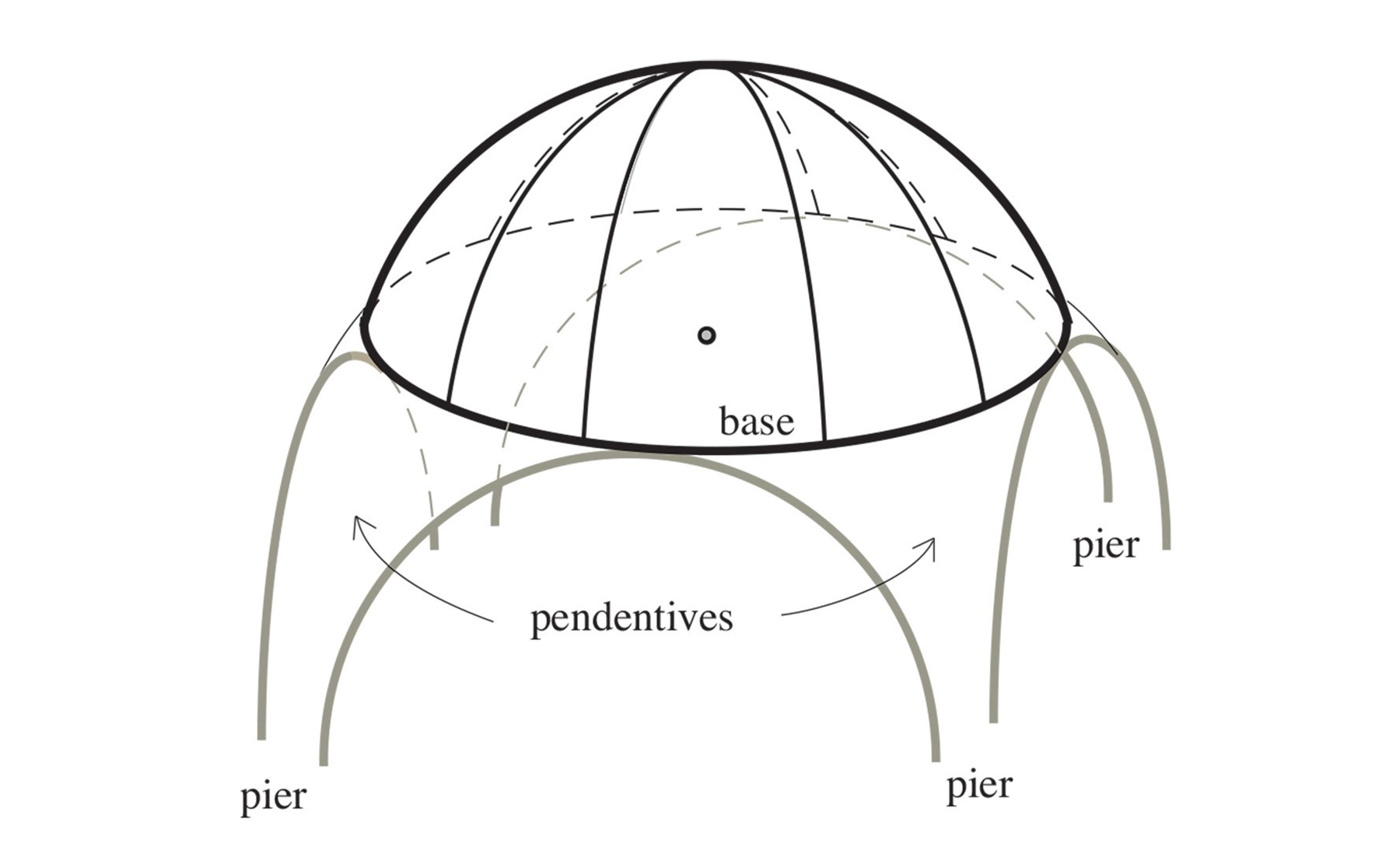
The fortunes of the church mirrored those of the empire it served. In decline since at least the 11th century, the Byzantine Empire finally collapsed in 1453 when the Ottoman Turks conquered the city and expanded the Ottoman Empire. Before the Turks’ arrival, Winston noted, the great capital had become diminished and impoverished and lay in ruins: “The great bazaars were almost devoid of produce, the great warehouses derelict and infested with rats. Many quarters of the city, once built-up and prosperous, had reverted to nature, with birds singing and wildflowers blooming in orchards and hedgerows.”
The Muslim Ottomans converted the church to a mosque, adding minarets, and restored the building. The great Ottoman architect Mimar Sinan designed a new array of buttresses at the base that may have allowed the building to continue standing. Hagia Sophia survived earthquake shocks in 1766 and 1802, but by the end of the 18th century, Winston wrote, the mosque had again “fallen into a state of disrepair.” In 1846, the Ottoman government hired two Swiss designers, brothers Giuseppe and Gaspare Fossati, to oversee yet another restoration of the structure. According to Winston, Gaspare complained about the conditions of the building, saying, “Already the vaults and the cracked domes were letting in the rain, the wind, and the snow” — to say nothing of the “clouds of pigeons.”
According to Winston, the brothers, beginning in 1847, straightened columns in the building and reinforced the north and south arches with tie rods to decrease their outward thrust. The Fossatis fortified the dome by wrapping it with a pair of iron chains: one, wrote Winston, “around the foot of the hemisphere and the other, concealed by a plaster cornice, around the square base.” Then they removed flying buttresses on the north and south sides of the dome, viewing them as structurally redundant. The brothers also, Winston noted, repaired some of the marble revetments on the interior of the building. The restoration was complete in 1849.
The rival cultures and societies that have laid claim to the Hagia Sophia have also left their imprint on the lavishly appointed interior of the house of worship. Centuries of Byzantine mosaics were laid, pulled out, and replaced. When the Ottomans came to power, they covered up many of the Christian mosaics. In 1847, Sultan Abdülmecid I commissioned famed calligrapher Kazasker Mustafa Izzet Efendi to install eight giant circular medallions in the mosque, featuring the names of Allah, Muhammad, Muhammad’s grandchildren, and Islam’s first four caliphs.
After World War I and the collapse of the Ottoman Empire, the founding father of the Turkish Republic, Mustafa Kemal Atatürk, secularized the mosque and opened it as a museum in 1935. As early as June 1931, the Turkish government gave the Byzantine Institute of America (part of the Dumbarton Oaks Research Library and Collection, in Washington, D.C.) permission to study and conserve the Byzantine mosaics. Atatürk recognized, as Winston noted, that the mosaics were treasures of Christian art that should be shown to the world “without Muslim inhibition or concealment.” (These efforts were led by American archaeologist Thomas Whittemore, along with Van Nice.)
In the 21st century, the historic dramas and intrigues continue. According to a 2008 article in Smithsonian Magazine, art historians and engineers still worry about conserving the mosaics and ensuring the building’s ongoing structural integrity (“A Monumental Struggle to Preserve Hagia Sophia,” Fergus M. Bordewich).
And last year, Recep Tayyip Erdoğan, the president of Turkey, converted the museum back to a mosque — a move that he claimed would not prevent non-Muslims from visiting the site as a cultural attraction but that has a new generation worried about the building’s fate. (Before the COVID-19 pandemic, the museum was visited by roughly 3 million to 4 million tourists a year.)
Almost 75 years ago, Van Nice assessed the value of the Hagia Sophia this way: Despite its “untested and somewhat illogical principle of support for the dome,” the speed of its construction, its exposure to earthquakes, and the “effects of time, decay, and intermittent neglect,” the great structure is not a “lifeless ruin” but instead “a vast and living laboratory.”
Van Nice valued this “living laboratory” because it affords historians and others the opportunity to study “the best techniques employed by known artists within precisely dated periods at intervals of four hundred years throughout the Byzantine epoch.” But the structure is a lab in another sense: It offers a chance to appreciate the resilience of human culture and ingenuity.
T.R. Witcher is a contributing editor to Civil Engineering.
This article first appeared in the January/February 2022 issue of Civil Engineering as “Tent of the Heavens: The Hagia Sophia.”



